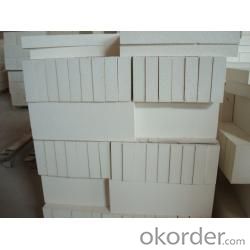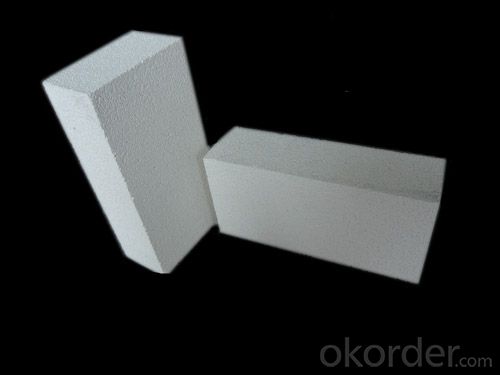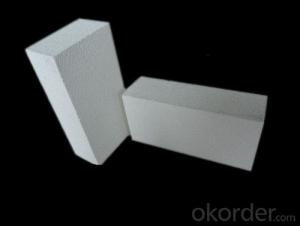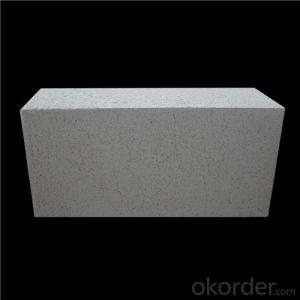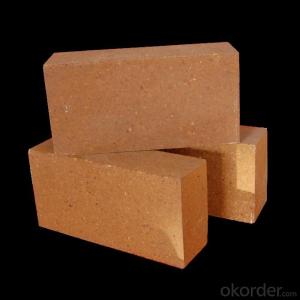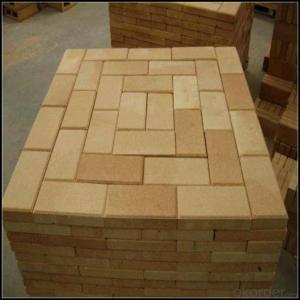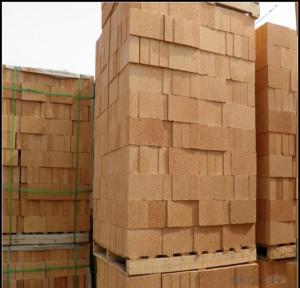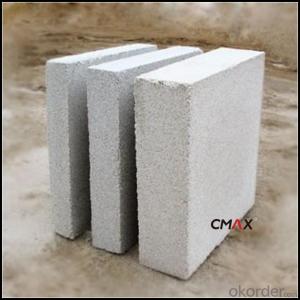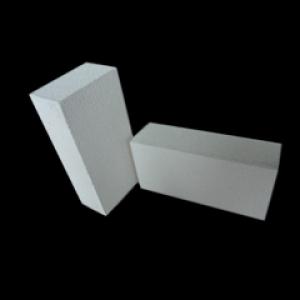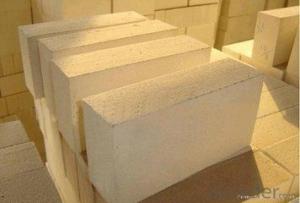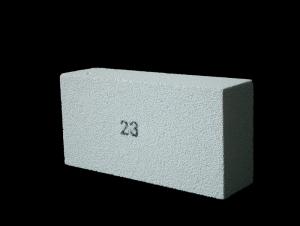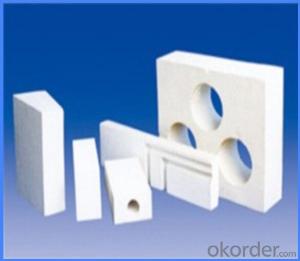Insulating Fire Brick for Fireplace
- Loading Port:
- Tianjin
- Payment Terms:
- TT OR LC
- Min Order Qty:
- 30 m.t.
- Supply Capability:
- 10000 m.t./month
OKorder Service Pledge
OKorder Financial Service
You Might Also Like
CNBM conforms strictly to the requirements of ISO 9000 quality control system during the production. MSDS is also available if you want. The thermal insulation fire clay brick meet with the requirements of ASTM & JIS standards. So pls stay cool with our quality.
Insulating Fire Brick Technical index
Product No. | IFB70 | IFB60 | IFB50 | IFB40 |
Al2O3 | 68%-72% | 58%-62% | 48%-52% | 38%-40% |
Refractoriness (°C ) | ≥1790 | ≥1790 | ≥1790 | ≥1790 |
Bulk density (g/cm3) | 2.50-2.60 | 2.35-2.45 | 2.20-2.30 | 2.10-2.20 |
Apparent porosity (%) | 22 | 19-22 | 17-20 | 17-20 |
Cold Crushing strength (kg) | 480-510 | 450-480 | 430-450 | 390-430 |
Application
Insulating Fire Brick are used for the lining of converter, alternating current arc furnace, direct Current arc furnace and the ladle slag line, etc.
Equipment
1 unit of Ceramic Abrasive (SG Abrasive) pilot production line
2 units of Compact grain Abrasive pilot production lines
1 unit of high-end coated abrasives (abrasive cloth) production line
2 units of Boron Carbide production lines
3 large flexible crushing and sieving lines for grit production lines
2 units of 2000KVA furnaces for Boron Carbide fusion
6 units of 5000KVA-10000KVA dumping type electric arc furnaces for Brown Fused Alumina fusion
Company Advantage
(1)Long Insulating Fire Brick manufacture history: 25 years manufacturer
(2)Advanced equipment
(3)Diversification of production standards: ISO ANSI FEPA JIS ASTM
(4)Flexible payment: T/T L/C D/P D/A
(5)Professional marketing team and after-sale service
(6)Free sample
FAQs
Q1 |
What’s the transport method? |
A1 | FCL delivery goods with wooden pallet or wooden case by sea; If LCL delivery, must with wooden case; Sometimes need open top, flat rack or bulk cargo. |
Q2 |
What’s the required payment term? |
A2 | Generally 30% TT as the prepayment, 70% TT before delivery. If need, 100% Irrevocable Letter of Credit or negotiation. |
Q3 |
Which country are our products exported to? |
A3 | Apart from entire Chinese market, the US, Russia, Japan, Korea, Australia and some Southeast Asian Nations. |
- Q: Can insulating fire bricks be used in electric furnaces?
- Yes, insulating fire bricks can be used in electric furnaces. These bricks are specifically designed to withstand high temperatures and provide excellent insulation, making them suitable for use in electric furnaces where heat retention is crucial.
- Q: Is it possible to recycle broken insulating fire bricks?
- It is indeed feasible to recycle damaged insulating fire bricks. These bricks are typically composed of recyclable materials like clay and alumina. After breaking, they can be crushed into tiny particles or ground into a fine powder. These fragments can then be blended with other substances to produce fresh bricks or alternative construction materials. Furthermore, certain recycling facilities may accept broken insulating fire bricks and repurpose them for use in various industries. By recycling these bricks, waste is minimized, resources are conserved, and the environmental consequences of manufacturing new bricks from scratch are reduced.
- Q: Can insulating fire bricks be used in residential construction?
- Insulating fire bricks, also known as refractory bricks, are primarily designed for use in high-temperature applications such as industrial furnaces and kilns. They are specifically engineered to withstand extreme heat, have low thermal conductivity, and provide excellent insulation properties. While insulating fire bricks can be used in residential construction, they are not typically the go-to choice for such applications due to several reasons. Firstly, insulating fire bricks are significantly more expensive compared to other types of construction materials available in the market. This cost factor often makes them less desirable for residential projects, where budget considerations are crucial. Secondly, the primary purpose of insulating fire bricks is to provide thermal insulation in high-temperature environments. In residential construction, the need for such extreme insulation is relatively rare. Standard construction materials like concrete blocks, bricks, or insulation boards can usually provide adequate insulation for residential buildings. Lastly, insulating fire bricks are not as structurally strong as other construction materials, which may make them less suitable for load-bearing applications in residential construction. These bricks are typically used as a secondary layer or lining in industrial furnaces, rather than as a primary building material. In conclusion, while insulating fire bricks can technically be used in residential construction, they are not commonly employed due to their high cost, limited applicability, and structural limitations. Residential construction typically relies on more cost-effective and versatile materials to meet insulation and structural requirements.
- Q: Can insulating fire bricks be used in the construction of refractory linings?
- Indeed, the utilization of insulating fire bricks is possible when constructing refractory linings. These bricks are explicitly engineered to possess exceptional thermal insulation characteristics, rendering them highly suitable for situations necessitating the containment of extreme temperatures. They are frequently employed in the establishment of furnaces, kilns, and other environments that experience elevated heat levels. The insulating attributes of these bricks aid in diminishing heat dissipation, enhancing energy efficiency, and upholding a consistent temperature within the refractory lining. Furthermore, insulating fire bricks are lightweight and effortless to manipulate, thereby constituting a pragmatic selection for the construction of refractory linings.
- Q: How do insulating fire bricks affect the overall indoor air quality of a building?
- Insulating fire bricks have a positive impact on the overall indoor air quality of a building. These bricks are designed to resist high temperatures and prevent heat transfer, which helps in maintaining a comfortable and consistent indoor temperature. By improving thermal insulation, they reduce the need for excessive use of heating and cooling systems, thereby minimizing the release of pollutants and improving energy efficiency. Additionally, insulating fire bricks are non-combustible, meaning they do not emit harmful gases or particulate matter when exposed to heat. This further contributes to a healthier indoor environment by reducing the potential for air pollution and respiratory issues.
- Q: What is the difference between the production line of foamed cement insulation bricks and the self thermal insulation block production line?
- I still feel that the special is better, specializing in the production of a product, at least quality and after-sale protection!
- Q: Can insulating fire bricks be used for insulation in refractory lining repair?
- Yes, insulating fire bricks can be used for insulation in refractory lining repair. Insulating fire bricks are made from lightweight materials that have excellent thermal insulation properties, making them ideal for use in high-temperature applications such as furnaces, kilns, and other refractory lining structures. These bricks have low thermal conductivity and high resistance to thermal shock, allowing them to effectively insulate and protect the refractory lining from heat, preventing heat loss and reducing energy consumption. Moreover, insulating fire bricks are easy to install and replace, making them a cost-effective choice for refractory lining repair.
- Q: Do insulating fire bricks require special installation techniques?
- Insulating fire bricks do not necessarily require special installation techniques, but there are certain considerations to keep in mind during the installation process. These bricks are designed to withstand high temperatures and provide thermal insulation, making them ideal for lining fireplaces, kilns, furnaces, and other high-temperature applications. While the installation process may vary depending on the specific application, there are general guidelines to follow. First, it is important to ensure that the surface where the bricks will be installed is clean and free of debris. This will help the bricks adhere properly and ensure a secure installation. Next, it is recommended to use a high-temperature refractory mortar or adhesive to bond the bricks together and to the surface. This mortar should be specifically designed for high-temperature applications to ensure its durability and resistance to heat. It is important to follow the manufacturer's instructions for mixing and applying the mortar. When installing the bricks, it is crucial to achieve proper alignment and tight joints to maximize the insulating properties of the bricks. This can be achieved by using a level and a rubber mallet to tap the bricks into place, ensuring they are evenly and tightly positioned. Additionally, it is important to allow for expansion and contraction of the bricks due to the high temperatures they will be exposed to. This can be done by leaving small gaps between the bricks and using expansion joints or flexible materials in areas where movement is expected. Finally, it is advisable to consult the manufacturer's guidelines and recommendations for specific installation techniques and considerations. Different types of insulating fire bricks may have slightly different requirements, so it is important to follow the instructions provided by the manufacturer. Overall, while insulating fire bricks do not require overly complex installation techniques, it is important to pay attention to details and follow the recommended guidelines to ensure a successful and long-lasting installation.
- Q: Can insulating fire bricks be used in outdoor applications?
- Insulating fire bricks are specifically designed for high-temperature applications and are commonly used in indoor environments such as kilns, furnaces, and ovens. While they are not typically recommended for outdoor applications, there are certain circumstances where they can be used with caution. Insulating fire bricks are made from lightweight refractory materials that provide excellent insulation and heat resistance. However, they are not as durable or weather-resistant as other types of bricks, such as clay or concrete bricks, which are more suitable for outdoor use. In outdoor applications, insulating fire bricks may be exposed to harsh weather conditions, including rain, snow, extreme temperatures, and UV radiation, which can cause them to deteriorate and lose their insulating properties over time. Additionally, these bricks are more susceptible to cracking and damage due to thermal expansion and contraction caused by temperature fluctuations. If you need to use insulating fire bricks in an outdoor application, it is important to take extra precautions to protect them from the elements. This can include using weatherproof coatings or sealants to minimize water absorption and prevent damage from freezing and thawing cycles. It is also crucial to ensure proper drainage and ventilation to prevent moisture accumulation, as excessive moisture can compromise the insulation properties of these bricks. Overall, while insulating fire bricks can be used in outdoor applications under specific conditions, it is generally recommended to use more suitable materials for long-term durability and performance.
- Q: Do insulating fire bricks require any special insulation blankets or jackets?
- Insulating fire bricks (IFBs) are designed to have excellent insulating properties, so they generally do not require any special insulation blankets or jackets. However, depending on the specific application and environment, additional insulation may be needed. If the IFBs are exposed to high temperatures or extreme thermal conditions, it may be beneficial to use insulation blankets or jackets to further enhance their insulation capabilities and protect them from damage. These additional insulation materials can help reduce heat loss, increase energy efficiency, and extend the lifespan of the IFBs. Therefore, while not always necessary, it is worth considering using insulation blankets or jackets in certain situations to optimize the performance of insulating fire bricks.
Send your message to us
Insulating Fire Brick for Fireplace
- Loading Port:
- Tianjin
- Payment Terms:
- TT OR LC
- Min Order Qty:
- 30 m.t.
- Supply Capability:
- 10000 m.t./month
OKorder Service Pledge
OKorder Financial Service
Similar products
Hot products
Hot Searches
Related keywords




